You can follow the history of henna art by following the lines of a tattoo. This art form has been used to cool the skin of desert dwellers, decorate the bodies of old kings, and now it grabs the hearts of people all over the world. It’s proof of how much people want beauty, a celebration of life’s important events, and a sign of luck and safety.
Henna tattoos are beautiful on more than just the surface; they are part of a cultural practice that is still growing and changing, and everyone is welcome to join in. Each design, from the delicate latticework on a bride’s hands to the bold geometric patterns that dance along the arms of festival-goers, is a work of art that will only last for a short time. It’s a glimpse into a world of tradition, beauty, and art. Let’s learn more about henna tattoos, where each line and mark is a memory in color.
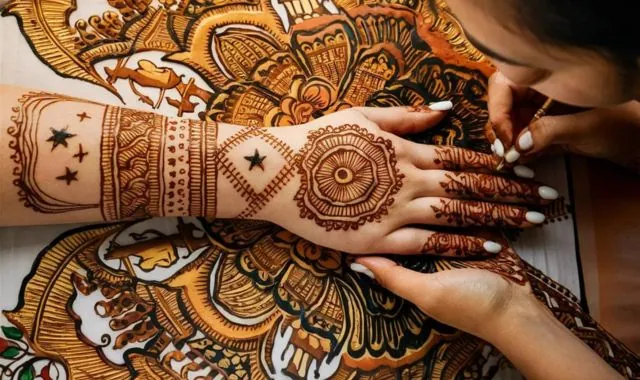
Benefits of Henna Tattoos
Henna tattoos have a lot of cultural meaning and are better than permanent tattoos in many ways. They honor custom and art while offering an easy and short-term option to permanent ink that lasts a lifetime. Here are some of the good things about it:
Painless Application:
Henna is put on the skin as a paste, while permanent tattoos need tools to go deep into the skin. This makes the process easy, so even complicated patterns can be made without any pain.
Temporary Nature:
People love henna tattoos because they only last for a short time, between one and three weeks. This lets people enjoy the beauty of body art without the long-term commitment, making it easy to switch patterns or completely stop getting tattoos.
Customizable Designs:
Henna art can be changed in many ways. Each design, from simple shapes to intricate artwork, can be changed to fit the person’s tastes. This design freedom is a big draw for people who want to be themselves and show themselves in a creative way.
Special Occasions:
People have been using henna for special events for a long time. It’s an important part of many cultures’ wedding traditions because it means health and wealth in the marriage. The more love and care it shows, the darker the henna stain. Henna is also a common sight at many holidays, like Eid al-Fitr and Diwali, where it adds to the joyous mood.
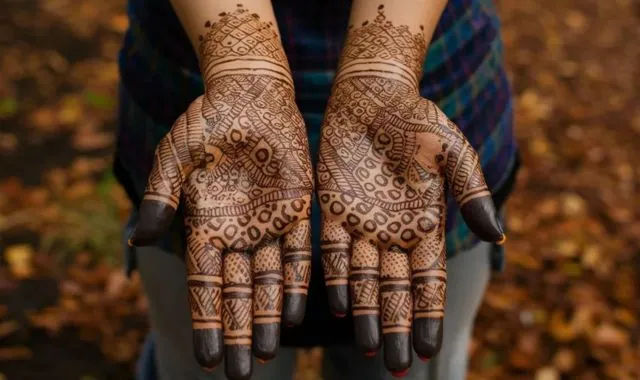
Henna Design Styles and Meanings
The types of henna designs are as different as the countries they come from, and each one has its own meaning:
Floral:
Floral designs are common in wedding henna because they reflect the start of a new life and are often used to indicate joy and happiness.
Geometric:
People think that these patterns, which have forms and order, will bring balance and peace into their lives.
Paisley:
In Indian henna patterns, the paisley pattern, which looks like a teardrop, is often used to represent fertility and good luck.
Arabic Calligraphy:
Arabic writing used in henna art, which is made up of words or sentences, often sends spiritual messages or blessings.
People who wear each style holds a special place in their hearts, not just because it looks nice, but also because it means something important to them. Henna designs take us back to the old ways of celebrating life’s important events, whether they’re a party, a rite of passage, or a sign of protection.
Natural vs. Chemical-Laden Henna Cones
Pure henna powder comes from the Lawsonia inermis plant and is mixed with natural things like sugar, lemon juice, and essential oils to make natural henna cones. People like this blend because it is thick and creamy and a brownish-green color. Henna that is grown naturally leaves behind an orange to red stain that stays on for 36 hours and up to 10 days.

Chemical-heavy henna cones, on the other hand, often have man-made ingredients like p-phenylenediamine (PPD) that can make you feel bad by making your skin itch, boil, or even have serious allergic reactions. These cones might offer a blackish-brown mark that shows up quickly and lasts longer, but they also come with a lot of risks.
High-Quality, Pre-Made Cones or DIY Natural Henna Powder
There are high-quality, already-made henna cones for people who would rather not have to make their own. The henna powder used to make these cones is usually fresh and natural, and they don’t contain any chemicals that are bad for you. For applying henna, they are a safe and useful choice.
People who like to do things on their own might choose natural henna powder, which lets you make any mix you want. You can make your own paste by adding things like spices, tea, and essential oils. You can change the consistency and smell to suit your tastes.
Identifying Safe and Natural Henna Cones
Here are some ways to make sure you’re using natural and safe henna:
Packaging:
Hand-rolled cellophane or Mylar cones that are clear or colored are what you need.
Storage:
To keep it fresh, natural henna should be kept in the freezer.
Smell:
It smells good, and it usually has hints of peppermint or lavender in it. Stay away from cones that smell stinky or chemical.
Color Test:
Use the henna paste to make a dot test on your skin. When natural henna is used, it leaves a light to bright orange mark. When chemical henna is used, it turns dark right away.
Transparency:
Find out from the seller what’s in it and when it was made. To tell if henna is natural, it needs to be completely clear.
Getting the right henna cone will not only give you a beautiful pattern, but it will also keep your skin safe and healthy. Getting the right supplies is very important whether you’re getting ready for a big event or just want to learn more about henna tattoos. Remember that if you want to safely try this old art form, you should always choose natural henna.
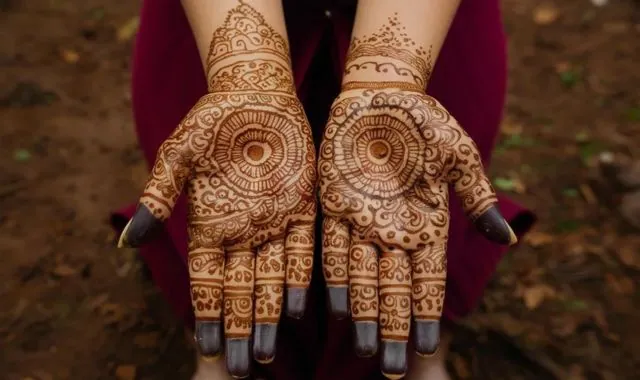
Preparing the Skin for Henna Application
Getting the skin ready for henna is an important step to make sure the design lasts as long as possible and leaves the best color. This is why:
Exfoliating and Cleaning the Skin:
By getting rid of dead skin cells, exfoliation makes the skin smooth for the henna paste to stick to. This not only helps you get a more even and detailed design, but it also keeps the henna stain on longer because it sticks to newer skin cells. To get rid of grease and dirt, wash the skin with soap and water or wipe it down with rubbing alcohol or witch hazel. This lets the henna paste fully enter the skin.
Using Natural Oils for a Better Stain:
Putting on natural oils like lemon or peppermint oil after cleaning can make the henna stain look better. These oils have chemicals in them that can help the henna color get deeper, making the stain darker and more vivid. People think that when they are put on the body, they make heat, which may help the henna oxidize and make the color look brighter.
Remember that getting ready is the most important part of getting a beautiful henna tattoo. By doing these things, you can get a beautiful henna pattern that lasts a long time and looks great.
Basic Henna Design Techniques
It’s fun to start your trip into the world of Mehndi by making simple henna patterns. Here are the steps you need to follow to make henna parts that are both easy and beautiful:
Basic Lines:
- Hold the henna cone like a pencil, applying gentle pressure to release the paste.
- Start with a small dot to anchor your line.
- Slowly drag the cone across the skin, keeping a consistent pressure for an even line.
Dots:
- Position the tip of the cone close to the skin.
- Gently squeeze to release a small amount of henna.
- Lift the cone straight up to leave a perfect dot.
Teardrop Shapes:
- Begin by creating a dot.
- While the henna is still wet, drag the cone down and away from the dot, tapering off to a point.
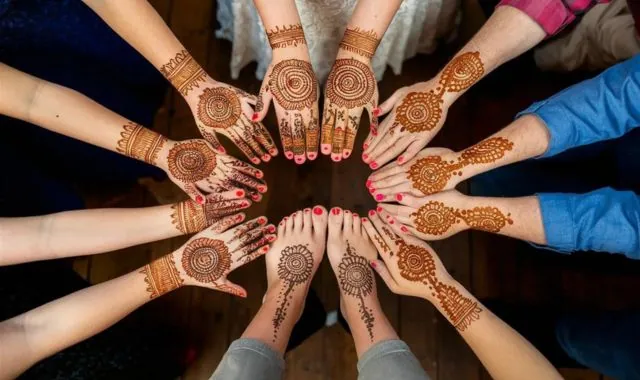
Essential Henna Application Tools:
Cones:
These are the most popular tools, and they give you power and accuracy. They have tips of different sizes for drawing lines of different widths.
Applicator Bottles:
Some people find it easier to hold and use these bottles, and they come with different-sized tips.
Practicing Your Technique:
You should try using henna on fake skin or paper before you put it on your body. You can get used to the pressure and movement needed to make beautiful images this way.
Don’t forget that practice and care are the keys to getting good at applying henna. Relax and let your imagination run wild!
Popular Henna Design Categories and Inspiration
Flowers used in henna designs are more than just pretty to look at; they also have deep cultural and symbolic meanings.
The lotus flower, which grows out of dark water and blooms beautifully, stands for cleanliness, knowledge, and spiritual growth.
With its classic beauty and scent, the rose is always thought of as a sign of love and desire.
Jasmine is often used in wedding henna because it is thought to bring good luck to the couple who just got married.
The mandala, which is a complicated and perfect shape, shows how life and the world are both balanced.
This art is carefully carved into the hands, arms, and feet, changing the body into a picture that displays a history and unique meaning. One example is the lotus, which is highly respected in Eastern countries for its spiritual meanings. Another is the rose, which is a universal symbol of love.
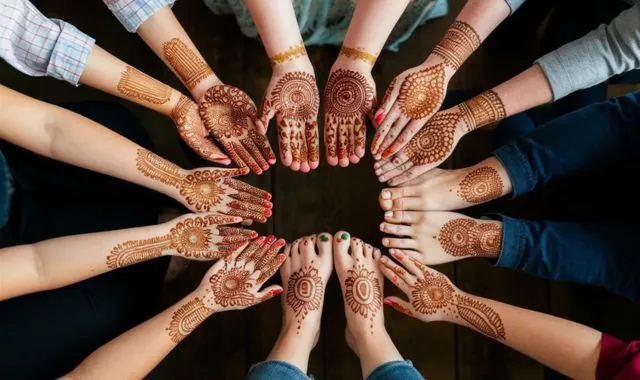
Geometric & Paisley Designs
Henna designs with geometric and paisley patterns have deep cultural meaning and are also beautiful. People think that geometric shapes, which are usually big and orderly, show the order and balance in the world. They are often used in Arabic and African henna designs because their clean lines and shapes give the patterns a sense of structure and unity.
Paisley designs:
These patterns, which are also called “mango” patterns, stand for birth, plenty, and success. Paiselys are often used in Indian Mehndi to wish the girl a happy and successful marriage. Henna artists love these designs because they are flexible and easy to use. They look like bent teardrops and have lots of small details.
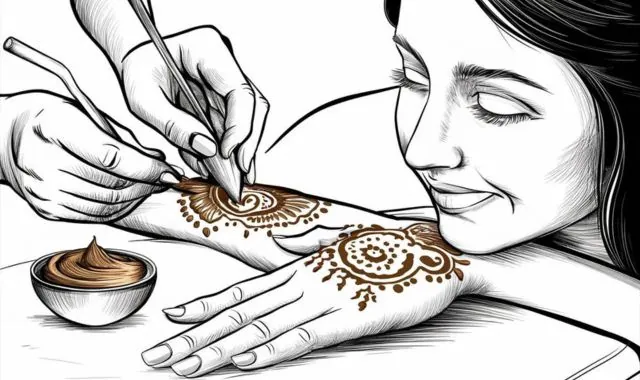
Mehndi Grids and Jaali Patterns
Mehndi grids and jaali patterns, which look like mesh and give the art more depth and texture, are two types of henna designs that use these elements. You can use these patterns on their own or mix them with other parts to make more complicated images.
Geometric shapes
Shapes that are mathematical are also used as borders and spaces in henna designs. They give the more detailed patterns something to fit into. They can be simple dots, lines, or more complicated forms that go with the main design and fill in blanks to make the Mehndi look more complex.
Arabic Calligraphy Designs
Arabic calligraphy, with its smooth, symmetrical writing, gives henna designs a touch of class and grace. Because Arabic letters have smooth edges and complicated shapes, they are often used in designs that are both beautiful and important.
Selecting Skilled Arabic Calligraphy Henna Designs
It’s very important to get your Arabic script henna patterns done by a skilled artist. A skilled artist will not only make sure that the design looks good, but they will also make sure that the script stays correct. It takes a lot of skill to use henna to make the fine lines of Arabic calligraphy look like real writing. Only a skilled artist can master the tricky techniques needed to create a work of art on the skin.
Examples of Arabic script in henna artwork:
Arabic writing can be seen in henna art by adding things like “love” and “peace” or even important names and times to the design. Sometimes, traditional patterns like flowers or paisleys are added to these letters to make the henna design look even more beautiful. The end result is a beautiful piece of art that can be worn and honors the rich history of Arabic writing.
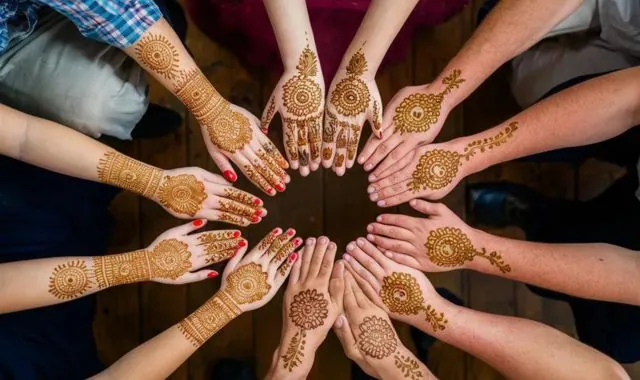
Henna for Special Occasions
Henna, also known as Mehndi, is an important part of weddings and other celebrations because it stands for happiness, beauty, and spiritual awakening. Bridal mehndi is a very complicated ritual that is done for weddings, especially in South Asian cultures. The bride’s hands and feet are covered in intricate patterns of peacocks, flowers, and paisleys that are meant to bring her luck as she starts her new life together. These patterns aren’t just pretty pictures; they’re prayers for love, happiness, and wealth.
Traditional red-brown color of henna
Shiny and shiny details have become popular for special events to go with the classic red-brown color of henna. When added after the henna has dried, these decorations make it look more colorful and can match jewelry or clothes. They take henna to a whole new level, making it even better for a party.
Advanced Henna Techniques and Tips
You can take your Mehndi art to a whole new level by learning advanced henna methods and tips. Here are some tips to help you get better:
Layering:
Adding layers to your drawings will give them more depth. Put down a main pattern, give it a little time to dry, and then add another design on top of it. This method gives your henna art a 3D look and makes it more complicated.
Shading:
You can change the shading by changing how much pressure is on the cone. When you use less pressure, the line is smaller, and when you use more pressure, the line is thicker. To give the image a darkened look, you can also leave some parts lighter.
Color Mixing:
Traditional henna leaves a reddish-brown mark, but you can change the color by using different natural ingredients. Like, adding beetroot juice can make the color redder, and adding coffee can make the mark darker.
Incorporating Glitter and Gems:
If you want to make the pattern look more festive, you can add glitter or small gems while the henna is still wet. This is very famous for wedding henna and other special events.
Precision Tools:
For the most control over your design, use fine-tipped brush bottles or even syringes (without needles) for detailed work.
Practice:
Practice is the only way to get better. Try doing the same thing over and over again on paper, fake skin, and other surfaces to build muscle memory and trust.
Continued Learning:
Take online classes or go to events to stay up to date on the newest styles and methods. Learning from experts can help you see things in new ways and give you new skills.
Shading and Layering Techniques
In henna design, shading and layers are important methods that give the art more depth and complexity. You can add shading with hatching (which involves drawing straight lines close together) and stippling (which involves adding dots to make texture and a gradient). These methods make it possible for areas of light and dark to change over time, which gives the pattern a three-dimensional look.
Layering
Putting different layers of design features on top of each other is what this means. To give it more depth, you could start with tiny lines, then add flowers or leaves, and finish with dots or swirls. This makes a rich, multi-textured look that can be made even better by adding different shades of henna or even colored glitters for a rainbow effect.
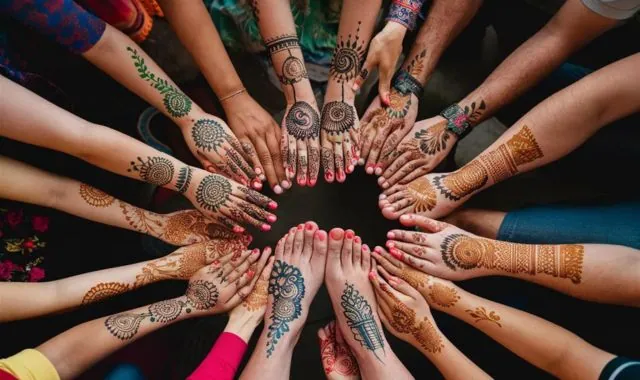
Creating Negative Space Designs
Negative space in henna designs is the skin that isn’t colored that shapes the pattern and makes it stand out. This method brings out the design by making it stand out without the henna, giving it a classy and modern look. As an example, the Marrakechi style makes a unique look by combining flower designs with empty space.
When making clothes for different body parts, think about these things:
Hands:
Choose complex mandalas or flower designs that flow from your fingers to your wrist, making use of the natural lines of your hand.
Arms:
Patterns that run around the arm, like geometric shapes or big paisley designs, look good.
Legs:
The length of the legs looks good with long, flowing patterns like flowers or tribal designs.
Feet:
Small anklet designs or intricate patterns on the top of the foot can draw attention to its shape.
For an appealing look, clothes must be made to fit the body’s curves. For example, a pattern that follows the curve of the back or goes around the shoulder can bring out the natural beauty of the body. It’s important to work with the body’s shape instead of against it so that the henna doesn’t look too heavy.
Maintaining the Henna Stain
Follow these treatment tips to keep the beauty of your henna pattern and make the color last as long as possible:
Maintaining the Henna Stain:
Sugar-Water Paste:
Use a sugar-water paste on the pattern after the henna has dried. This helps the henna stay in place for a longer time by sealing it.
Avoid Water:
Don’t get water on the henna pattern for the first 24 hours. This gives the color time to dry and get darker.
Removing Henna Stains Naturally:
Oil Exfoliation:
Apply a light layer of oil, like coconut or olive, to the henna color and scrub it off with a loofah or towel. The oil helps break down the henna color, and the scrubbing gets rid of the top layers of skin that the henna is on.
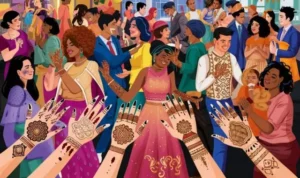
Lemon Juice Scrub:
You can use lemon juice, which is a natural bleach, on the henna stain and scrub it slightly to help fade the color. Lemon can dry you out, so make sure to moisturize afterward.
These methods are natural and safe ways to either keep your henna pattern or get rid of it when you want to try something new. Remember that you need to be patient because the mark will go away on its own over time.
Conclusion
Mehndi is a very colorful art form, and henna tattoo designs are a special way to express yourself artistically and culturally. Each design in the natural color of the henna plant tells a story. The detailed flower patterns mean “new beginnings,” while the bold geometric forms mean “the balance of the universe.” From the different styles, methods, and meanings of the old art form to how it is still loved in many countries and situations, this guide has shown how it has changed over time.
 Life Styles Up All About Fashion Related Hub
Life Styles Up All About Fashion Related Hub
Henna Tattoos designs so beautiful